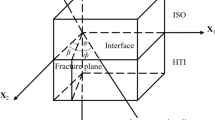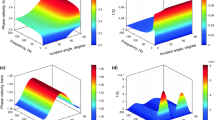Abstract
In fractured reservoirs, the seismic response characteristics are more complex than in conventional reservoirs because of their inherent properties of anisotropy and dispersion-attenuation, increasing the multiplicity of the prediction solutions and making fluid identification more difficult. Since fluid saturation is a crucial parameter that can directly affect these inherent properties, its effect on F-AVAZ (frequency-dependent amplitude versus angle-azimuth) seismic response characteristics of fractured reservoirs is studied in this article. Using Norris and KG models, an effective partially saturated fractured porous medium is established. Based on the anisotropic reflectivity algorithm, the deterministic relationship between F-AVAZ and fluid saturation is obtained. The numerical simulation results of the three-layer model show that when oil–water coexists in fractured reservoirs, F-AVAZ gradually changes with growing water saturation. While the fluid changes from fully water saturated to gas bearing, F-AVAZ suddenly jumps because of the rapidly decreasing effective P-wave modulus. This abrupt increase of P-wave amplitude is the classic 'bright spot' phenomenon, which verifies the validity of the anisotropic reflectivity algorithm based on the Norris-KG model for fractured reservoirs. This study lays a solid theoretical foundation for the analysis of seismic response characteristics of multi-phase fluid saturated fractured reservoirs and provides a reliable theoretical basis for improving reservoir prediction and fluid identification accuracy.











Similar content being viewed by others
Data availability
The Matlab scripts can be downloaded from GitHub (https://github.com/kly0412/kly0412.git).
References
Backus, G. E. (1962). Long-wave elastic anisotropy produced by horizontal layering. Journal of Geophysical Research, 67, 4427–4440.
Booth, D. C., & Crampin, S. (1983). The anisotropic reflectivity technique theory. Geophysical Journal Royal Astnomical Society, 72, 755–766.
Brajanovski, M., Gurevich, B., & Schoenberg, M. (2005). A model for P-wave attenuation and dispersion in a porous medium permeated by aligned fractures. Geophysical Journal International, 163, 372–384.
Carcione, J. M. (2000). A model for seismic velocity and attenuation in petroleum source rocks. Geophysics, 65, 1080–1092.
Carcione, J. M., Gurevich, B., & Santos, J. E. (2013). Angular and frequency-dependent wave velocity and attenuation in fractured porous media. Pure & Applied Geophysics, 170, 1673–1683.
Fryer, G. J., & Frazer, L. N. (1987). Seismic waves in stratified anisotropic media-II. elastodynamic eigensolutions for some anisotropic systems. Geophysical Journal Royal Astronomical Society, 91, 73–101.
Fuchs, K., & Muller, G. (1971). Computation of synthetic seismograms with the reflectivity method and comparison with observations. Geophysical Journal Royal Astronomical Society, 23, 517–433.
Gelinsky, S., & Shapiro, S. A. (1997). Poroelastic Backus averaging for anisotropic layered fluid- and gas-saturated sediments. Geophysics, 62, 1867–1878.
Guo, Z. Q., Liu, X. W., Fu, W., & Li, X. Y. (2015). Modeling and analysis of azimuthal AVO responses from a viscoelastic anisotropic reflector. Applied Geophysics, 12, 441–452.
Jin, Z. Y., Chapman, M., & Papageorgiou, G. (2018). Frequency-dependent anisotropy in partially saturated fractured rock. Geophysical Journal International, 215, 1985–1998.
Kennett, B. L. N. (1983). Seismic wave propagation in stratified media (pp. 1–437). Cambridge University Press.
Kong, L. Y., Gurevich, B., Müller, T. M., Wang, Y. B., & Yang, H. (2013). Effect of fracture fill on seismic attenuation and dispersion in fractured porous rocks. Geophysical Journal International, 195, 1679–1688.
Kong, L. Y., Gurevich, B., Zhang, Y., & Wang, Y. B. (2017). Effect of fracture fill on frequency dependent anisotropy of fractured porous rocks. Geophysical Prospecting, 65, 1649–1661.
Krzikalla, F., & Müller, T. (2011). Anisotropic P-SV-wave dispersion and attenuation due to inter-layer flow in thinly layered porous rocks. Geophysics, 76, WA135–WA145.
Lambert, G., Gurevich, B., Brajanovski, M. (2005). Frequency-dependent anisotropy of porous rocks with aligned fractures. In: Proceedings of 3rd Biot Conference on Poromechanics., pp. 309–314.
Lan, H. T. (2014). Wave Field Modeling in Fractured Porous Media and Frequency-dependent AVO Reservoir Parameters Inversion. Dissertation for Doctoral Degree. Changchun: Jilin University (in Chinese).
Liang, K. (2009). The study on propagation feature and forward modeling of seismic wave in TI media. Dissertation for Doctoral Degree. Dongying: China University of Petroleum (EastChina) (in Chinese).
Liu, B. H., Yang, Q., Shi, Z., Zhou, W., & Zheng, S. L. (2010). Azimuthal AVO simulation for HTI media. Geophysical Prospecting for Petroleum, 49, 232–239 (in Chinese).
Ma, Y W. (2003). Reflectivity seismic modelling in stratified earth models with applications in gas hydrate exploration. Dissertation for Doctoral Degree. Kingston: Department of Geological Science and Geological Engineering, Queen's University.
Mallick, S., & Frazer, L. N. (1990). Computation of synthetic seismograms for stratified azimuthally anisotropic media. Journal of Geophysical Research, 95, 8513–8526.
Mao, N. B., Xie, T., Yang, K., & Jin, M. X. (2008). Azimuthal AVO forward for fractured reservoirs and its application. Journal of Oil and Gas Technology, 30, 59–63. in Chinese.
Mo, W. L., & Wu, C. D. (2007). Mulyi-azimuthal AVO analysis of fractured reservoirs. Natural Gasgeoscience, 18, 813–818. in Chinese.
Norris, A. N. (1993). Low-frequency dispersion and attenuation in partially saturated rocks. Journal of the Acoustical Society of America, 94, 359–370.
Rao, Y., Wang, Y., & Han, D. (2019). Seismic waveform tomography with simplified restarting scheme. IEEE Geoscience and Remote Sensing Letters, 16, 135–139.
Rüger, A. (1998). Variation of P-wave reflectivity with offset and azimuth in anisotropic media. Geophysics, 63, 935–947.
Schoenberg, M., & Douma, J. (1988). Elastic wave propagation in media with parallel fractures and aligned cracks. Geophysical Prospecting, 36(6), 571–590.
VavrycukPsencik, V. I. (1998). PP-wave reflection coefficients in weakly anisotropic elastic media. Geophysics, 63, 2129–2141.
Wang, Y. (2016). Seismic Inversion: Theory and Applications. Publisher.
Wang, R., & Wang, Y. (2017a). Multichannel algorithms for seismic reflectivity inversion. Journal of Geophysics and Engineering, 14, 41–50.
Wang, R., & Wang, Y. (2017b). Seismic reflectivity inversion by curvelet deconvolution: A comparative study and further improvements. Journal of Seismic Exploration, 26, 331–349.
Wang, Y., & Rao, Y. (2020). Seismic, waveform modeling and tomography. In H. K. Gupta (Ed.), Encyclopedia of solid earth geophysics (2nd ed.). Springer.
Xu, G. M., Li, Y., Ni, S. D., & Wang, H. B. (1996). Research on equivalent azimuthal isotropy of thin interbed medium. OGP, 31, 792–805 (in Chinese).
Xu, K., Xiao, P. F., Cao, H. L., Ding, J., Lin, Z., Chen, W. S., Liu, Y. Azimuthal frequency-dependent AVO inversion and its application in deep carbonate reservoirs in Tahe Oilfield China. In: SEG Technical Program Expanded Abstracts 2015, pp. 644–648.
Xun, H., Dong, M. Y., & Mou, Y. G. (1997). Wave field simulation using reflectivity method and body-wave radiation patterns in anisotropic media. Oil Geophysical Prospecting, 32, 605–614. in Chinese.
Yao, J., Zheng, J. G., Li, J., Liu, J., & Sun, H. F. (2012). Azimuth AVO analysis of dip interface of anisotropic medium and its application. Journal of Oil and Gas Technology, 33, 68–72. in Chinese.
Yin, X. Y., Zhao, J., Zhang, F. C., Sun, C. Y., & Luo, H. Z. (2006). Method of generating prestack synthetic seismograms of spherical wave. Journal of China University of Petroleum: Edition of Natural Science, 30, 26–32. in Chinese.
Acknowledgements
This work was partially funded by Geological Survey Project (no. DD20230325, DD20230044, DD20221653).
Author information
Authors and Affiliations
Contributions
WL completed the article writing, HZ and LK completed the formula derivation and data analysis, HL and YZ completed the program writing, and YM completed the map editing and format adjustment.
Corresponding author
Ethics declarations
Competing interests
The authors declare no competing interests.
Additional information
Publisher's Note
Springer Nature remains neutral with regard to jurisdictional claims in published maps and institutional affiliations.
Rights and permissions
Springer Nature or its licensor (e.g. a society or other partner) holds exclusive rights to this article under a publishing agreement with the author(s) or other rightsholder(s); author self-archiving of the accepted manuscript version of this article is solely governed by the terms of such publishing agreement and applicable law.
About this article
Cite this article
Luo, W., Zhou, H., Kong, L. et al. Effect of Fluid Saturation on Frequency-Dependent AVAZ Seismic Response Characteristics of Fractured Reservoirs. Pure Appl. Geophys. 180, 2673–2688 (2023). https://doi.org/10.1007/s00024-023-03288-w
Received:
Revised:
Accepted:
Published:
Issue Date:
DOI: https://doi.org/10.1007/s00024-023-03288-w




